OREGON COUNTRY FAIR
Booth Construction and Maintenance Manual
2004
|
The main document (below) is an implementation of a "smart building code" that uses The Fair's red-tag booth inspection process to power the transition of our collection of funky non-conforming structures into structures that gracefully conform to The Fair's Land Use Management Plan (The LUMP).
The Fair is located in a "frequently flooded area" near the Fern Ridge Reservoir and much of the site is inundated on an annual basis. Controlling erosion and eliminating off-site liability for floating objects that originate on the Fair's property present serious challenges and the Fair's long-standing red-tag process has been adapted to address these issues, as well as the structural problems the Fair's inspections have always addressed. The Fair controls erosion on the site by encouraging a vegetative mat to cover the ground, preventing erosion of exposed soil. This requires that sun-light reach the ground. The picture at the right clearly shows how a "temporary" structure can allow vegetation to regrow in the months post fair and prevent erosion.
| 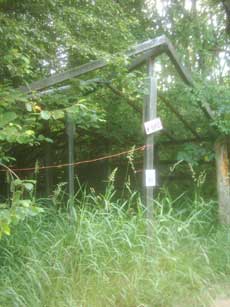 |
Drainfield Issues and Explanations
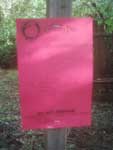 | Much of the Fair's property is an archaeologically significant zone and many specific areas of the site have been designated as "no-dig zones". This means that no ground disturbing activity is permitted without review and permission. This does NOT mean that permission is difficult to obtain; staff is available to expedite your excavation needs. Print this page for more specific information regarding OCF Drainfield Issues, Drawings and Drainfield Inventory Form - ready to print. 35 KB - contains a pretty clear explanation and a schematic drawing that I hope you can read. Pick up a clearer drawing at the construction desk when you arrive on site. |
|
DOWNLOAD OCF BOOTH CONSTRUCTION AND REPAIR MANUAL |
Do not doubleclick the images of leaves in fall unless you have a fast connection to the internet - instead, select the image and then download the source that it links to - (that process is a menu choice called called "Save target file as " in Explorer, and "Save Link as" in Netscape) to your local machine, then open it in Adobe Acrobat Reader and print from there.
It is all black and white and grayscale, and should print fine on either a Mac or a PC. I created these files in Word2k and then printed them to Acrobat 4.0, so any recent version of Acrobat Reader can open and print them. Try a small file that prints just 1 page first, just to be sure. Most pages contain both text and graphics. |
Construction Permit Application
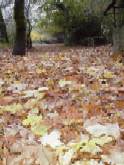 | OCF Booth Construction Permit Application - ready to print.
341 KB - contains a pretty detailed set of plans for a portable booth, drawn by Ed Criss.
The Fair's Booth Construction and Repair Manual provides the roadmaps for maintaining and designing booths for use at the Fair.
Think of it like a building code. |
|
End of the Fair Checklist for BoothReps
 | End of the Fair Required Actions Checklist for Booth Reps - ready to print.
Only 22 KB - One page |
|
Booth Manual Cover
 | Cover for Booth Construction and Maintenance Manual 2004 that should be ready to print.
Only 62 KB |
|
The Booth Manual
 | The Booth Construction and Maintenance Manual, in PDF format that also should be ready to print.
The manual is a 3.43 MB file in PDF format and prints 52 pages. (July 5th version is currently posted) Next version will be formatted as a clickbook for 2-sided printing with facing page headers and footers.
|
Alternately these files are all stored in the www.breskin.com/ocf directory - click there to open it and download from there. If you have difficulties call me at (360) 385 3771 before the fair or come to construction and ask for "Red Tag Joe".
|
|
Helping the booth reps resolve the issues that had led to the Fair's "red tags" so the red tags could removed from their booths is a fantastic opportunity to get everyone on the same page. Red Tags are posted by The Fair during the pre-fair build-up to indicate structural defects, and before the Booth can be occupied these structural defects must be remedied and the red tags removed by the Fair.
Getting booths ready for red-tag removal is a fascinating adventure, with literally hundreds of things happening at once, and last year I learned a great deal about "flow" and about the need to keep both feet firmly planted in the present if one hopes to accomplish anything. I eventually began to recognize a pattern emerging in my interactions with people who had booth problems to solve: it really seemed like every second that we spent re-hashing the past got both of us just that many seconds out of sync with everything else that was going on, and that these re-hashes were not really even therapeutic for the people wanting to go back into the past - because there were no solutions to be found in the past - the solutions to the problems that we were going to solve in the immediate future were only to be found in the immediacy of the moment we were sharing.
Last year I collected another image gallery of Mavica shots from pre-fair: but more focused - meaning that all the images have an intent or agenda - it contains lots of booth construction details.
The good, the bad, and the ugly.
These may seem like rather esoteric technical documents if you don't have a booth at the Country Fair.
But they are essential, must-read documents if you do.
|
|
Here are a few more important documents and websites related to the Fair:
|
|  | Andy Strickland's Caretaker's Journal - Best description of the 'Real' aspects of the Country Fair I know how to share.
|
| 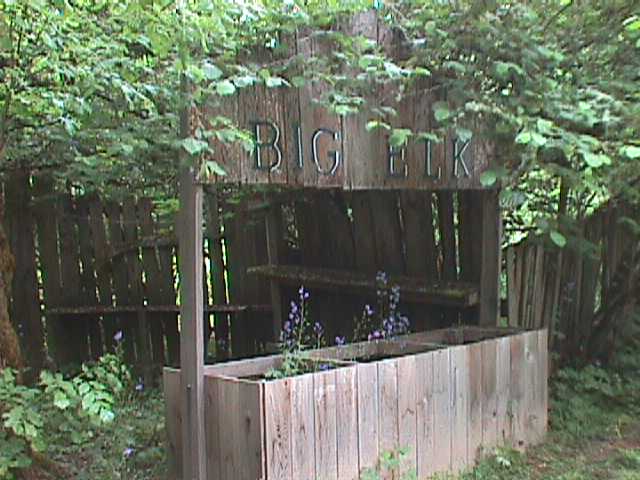 | A rough gallery of images from pre-fair one spring (1999) shot for Grace Tara who could not be there. |
| 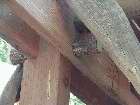 | Another VERY rough gallery of booth construction images from pre-fair 2001. I never intended the public to look at these upsidedown and sideways images, and I will clean this mess up as soon as I get back... |
|  | The OFFICIAL Oregon Country Fair website. |
| This year's Country Fair Entertainment Schedules. |
|  | The OrcaLab bus and banner got to the be part of Country Fair 2000. Hope they get to come back some day. |















